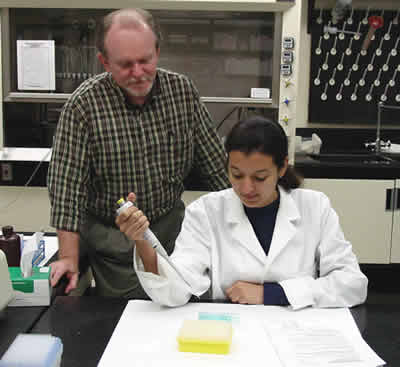|
Drug
regulations set by LSU School of Veterinary Medicine used by horse
racing commissions internationally
BATON
ROUGE – The LSU School of Veterinary Medicine (SVM) has been
the drug-testing site of the Louisiana State Racing Commission (LSRC)
since 1987, and the guidelines established by SVM pharmacologists
are used throughout the nation and in other countries.
Dr. Charles R. Short, a professor of veterinary pharmacology in
the Department of Comparative Biomedical Sciences at the SVM, was
the first person to create a set of guidelines that classified drugs
based on their nature, effects and use patterns and established
penalties that corresponded with the severity of the drug used.
Short’s first system had three levels and classified between
450 and 500 drugs. In 1990, Short presented a refined, five-tiered
system of drug classification at the 9th International Conference
of Racing Analysts and Veterinarians, which he organized in New
Orleans. Class 1 drugs are the most severe and carry the most penalties;
Class 5 drugs are the least severe and have little effect on the
horse’s performance. There are currently over 750 drugs listed
in the classification system, called the Uniform Classification
Guidelines for Foreign Substances and published by the Association
of Racing Commissioners International.

As
Chair of the Association of Racing Commissioners International’s
Veterinary Pharmacology Committee, SVM professor Dr. Charles Short
is responsible for reviewing and updating the horse racing drug
classification guidelines he established almost 15 years ago.
·
Class 1 drugs are stimulants and depressants that have the highest
potential to affect the performance of the horse, making them run
faster or slower than normally capable. Most of these drugs are
narcotics that are depressants in people but stimulants in the horse.
· Class 2 drugs also have a high potential to affect performance
and are either not generally used for therapeutic purposes or are
therapeutic agents that have a high potential for abuse. Most of
these drugs are approved only for use in people and include such
agents as mood-altering drugs.
·
Class 3 drugs may or may not have a generally accepted medical use
in the racing horse, but still have potential to affect performance,
though less than those agents in Class 2.
·
Classes 4 and 5 include widely used therapeutic medications that
have little effect on performance.
·
The guidelines also contain a list of drugs that are commonly used,
such as antibiotics, but have no effect on the performance of a
horse and are therefore not classified.
“When
a drug is found in a horse, it is important to determine the seriousness
of the effects; was the outcome of the race altered? The use of
the guidelines provide a more even playing ground for everyone in
the horse racing industry,” said Short.

Dr. Steven Barker, SVM professor and state chemist for the Louisiana
State Racing Commission, oversees drug testing of racehorse samples
conducted by research associate Pamela Casas. The LSU School of
Veterinary Medicine has been the site of all racehorse drug testing
in the state since 1987.
Short was assisted in creating the drug guidelines by Dr. Steven
A. Barker, professor of veterinary physiology, pharmacology and
toxicology in the Department of Comparative Biomedical Sciences
at the SVM, and Dr. Steven G. Kamerling, a former SVM professor
of veterinary pharmacology.
The guidelines are today widely referred to by racing commissions
in the United States, as well as in a number of foreign countries
that have horse racing such as India, Brazil, Argentina, Chile and
Jamaica.
Barker has served as the State Chemist for the LSRC since 1987 and
oversees the drug testing of all racehorses in the state. He estimates
that approximately 70,000 samples have been tested at the SVM from
horses on the four racetracks in Louisiana since testing began.
All first-place winners are tested and other horses in each race
are tested at random. Penalties range from a five-year suspension,
$5,000 fine and loss of purse for Class 1 violations, to no suspension
with possible loss of purse or fine for a Class 5 violation.
“Drugs
in Classes 1 and 2, and some in Class 3, should never show up in
a horse, but we look at each case on an individual basis,”
noted Barker.
Very few horses involved in the state’s racing industry test
positive for drugs of any kind.
“Only
0.25 percent of all horses tested come back positive for a drug
in any of the five categories. For Class 1 and Class 2 drugs, it
is closer to 0.01 percent of all samples taken,” said Barker.
The guidelines get reviewed every six months by the Association
of Racing Commissioners International’s Veterinary Pharmacology
Committee, of which Short is the chair. He and the other committee
members go through the new FDA drug approvals, classify any new
drugs into the five-tier system and re-classify drugs if necessary.
Barker says that it is a constant challenge to keep up with what
drugs are being used because new drugs are coming out constantly.
That is why the SVM devotes time and money in research and development
to find methods of detecting the new drugs.
Recently the school invested $330,000 in new instrumentation to
detect and confirm the newest drugs of abuse in racehorses, which
are protein and peptide-related drugs that include growth hormones
and muscle and blood builders.
There is now an effort to establish a set of national standards
in the rules of racing, including drug penalties. While the guidelines
established by the SVM professors are widely used, the rules vary
by state as to what drugs are permissible and in what quantity.
Barker is working with his counterparts in other states to standardize
the regulations, as well as to create a common understanding of
the drugs used and their effects.
Aside from ensuring the races are run fairly, detecting performance
drugs in horses is important because they can be harmful to the
animals. Horses given performance drugs will outrun their pain and
ability and literally break down.
“One
of the real values of drug testing is that it allows us to protect
the people and the horses involved in the racing industry,”
said Barker.
|







